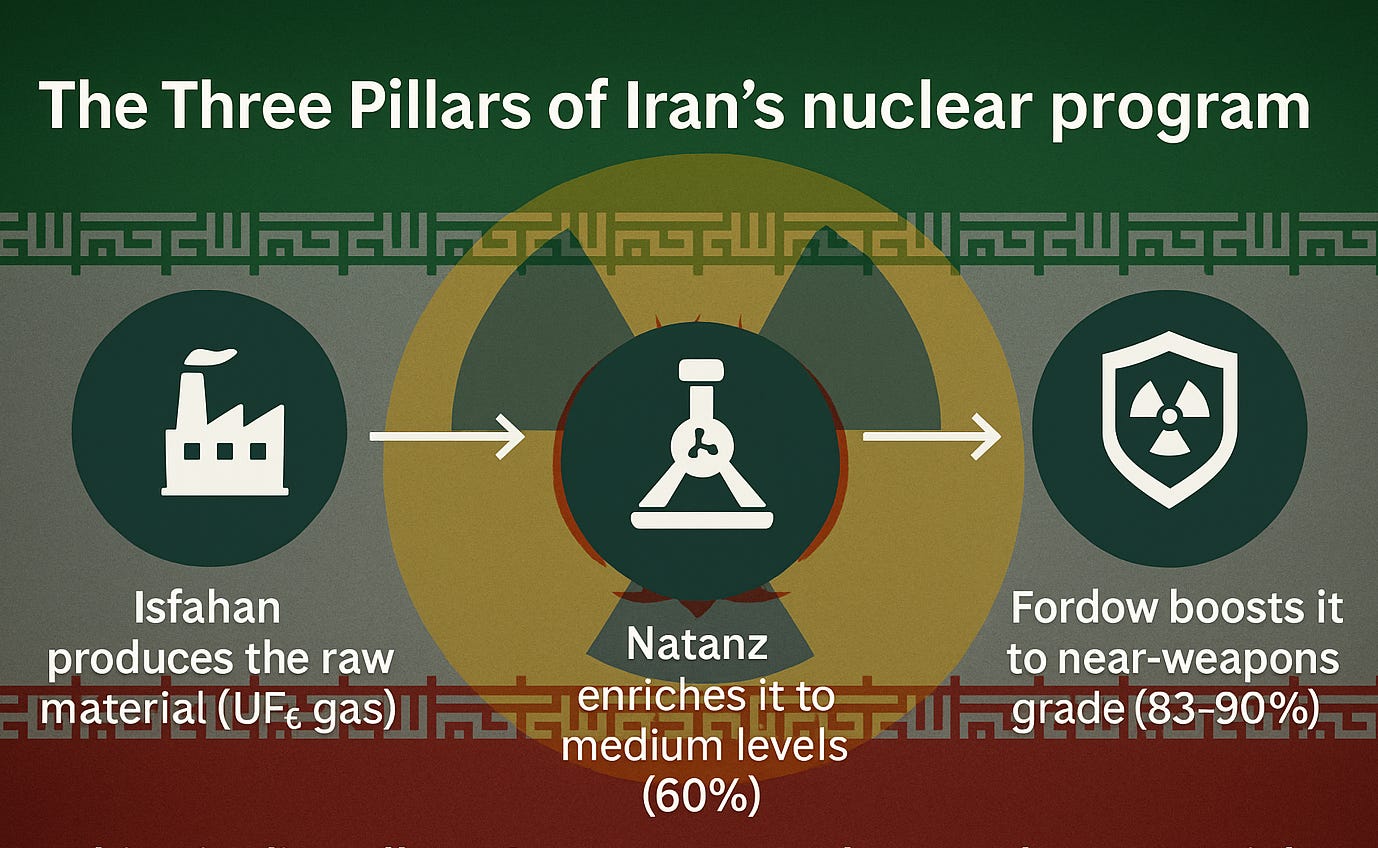Understanding the Three Pillars of Iran's (Now-Destroyed) Nuclear Program
These three facilities are the backbone of Iran’s nuclear weapons program: Isfahan fuels the process, Natanz industrializes it, and Fordow shelters it, allowing Iran to build a nuclear weapon in weeks
In a decisive and highly coordinated operation, President Donald Trump announced Saturday evening that U.S. forces had successfully struck three of Iran’s most critical nuclear facilities- Natanz, Isfahan, and Fordow- marking the first direct American military action against Iran’s nuclear infrastructure since the 1979 revolution. The U.S. deployed B-2 stealth bombers and Tomahawk missiles with precision, targeting what Trump described as Iran’s "key nuclear enrichment facilities," and declaring the mission a “spectacular military success”.
These sites—Isfahan, Natanz, and Fordow—form the backbone of Iran’s clandestine nuclear weapons capability: Isfahan supplies the process, Natanz industrializes it, and Fordow shelters it deep underground. Together, these facilities enabled Iran to approach nuclear weapon breakout capability within weeks. While all facilities have other uses, this is how they work together.

Isfahan: The Beginning of the Nuclear Chain
The Uranium Conversion Facility (UCF) near Isfahan is the starting point for Iran’s nuclear ambitions. This facility converts uranium ore, or yellowcake, into uranium hexafluoride (UF₆) gas—the essential precursor for enrichment. Without UF₆, Iran’s enrichment operations would grind to a halt. While the technology can be used for civilian purposes, its role in producing weapons-grade material is undeniable. Iran additionally stores highly enriched uranium here. The Isfahan complex also hosts centrifuge production facilities,
Founded in the 1980s with Chinese technical assistance, Isfahan’s facility has long been the focus of international concern. The International Atomic Energy Agency (IAEA) has repeatedly cited Iran for incomplete reporting and restricted access at Isfahan, raising persistent fears that nuclear materials could be diverted for secret military use. By striking Isfahan, the U.S. aimed to sever the upstream supply chain, disrupting Iran’s ability to sustain its enrichment activities and sending a clear message that the international community will not tolerate nuclear subterfuge.

Natanz: Iran’s Industrial Enrichment Hub
The Natanz nuclear facility, located in central Iran, is the centerpiece of the country’s uranium enrichment operations. Its existence was concealed from the world until exposed by Iranian dissidents in 2002, after years of secret construction. Since then, Natanz has expanded into a sprawling, fortified complex housing up to 50,000 centrifuges—machines that enrich uranium to higher concentrations of the isotope U-235. While civilian reactors require uranium enriched to just 3–5%, Natanz has produced uranium at 60% purity, alarmingly close to weapons-grade.
Natanz has repeatedly drawn international condemnation for its lack of transparency and history of deception. Built in secret and protected by reinforced underground structures, the facility has required the U.S. to employ advanced bunker-busting munitions to ensure effective targeting. The scale, output, and fortification of Natanz made it a central target for the U.S.- a necessary step to impede Iran’s progress toward a nuclear weapon and uphold global security.

Fordow: The Hardened ‘Break-Out’ Facility
The Fordow Fuel Enrichment Plant, buried deep within a mountain near Qom, is Iran’s most secure and secretive nuclear site. Originally constructed in the early 2000’s with the explicit purpose of producing nuclear weapons material in secrecy, Fordow was only acknowledged by Iran after its existence was uncovered by Western intelligence in 2009. Iran repeatedly misled the international community about Fordow’s true purpose, denying its military intent even as it prepared for high-level enrichment.
Fordow is equipped with roughly 3,000 centrifuges and was reactivated for high-level enrichment after Iran’s partial withdrawal from the 2015 nuclear deal. It is capable of rapidly enriching uranium from the 60% produced at Natanz to weapons-grade levels. In 2023, the IAEA detected uranium enriched to 83.7% at Fordow- just shy of the 90% threshold for nuclear weapons. The facility’s location and advanced technology make it the crown jewel of Iran’s enrichment program, and a direct threat to international stability if left unchecked.
How the Three Pillars Work Together
The integration of Isfahan, Natanz, and Fordow forms a seamless and dangerous nuclear supply chain. Isfahan produces the UF₆ gas, Natanz enriches it to intermediate levels, and Fordow can swiftly boost it to weapons-grade. Together enabling Iran to enrich uranium for weapons within a week. Each facility is essential; eliminating only one disrupts the entire process, but does not remove it. This distributed, hardened structure is designed to frustrate international oversight and complicate any effort to halt Iran’s nuclear ambitions.
The history of these sites is marked by systematic deception. In the 1980s and 1990s, Iran secretly conducted uranium conversion experiments at Isfahan. Natanz was built in secret and only revealed in 2002, while Fordow’s existence was hidden until 2009. Stolen Iranian nuclear archive documents later confirmed that Fordow, designed under the covert “Amad Program” (1999–2003), and Natanz were both intended to advance weapons potential while evading oversight.
Even during negotiations in 2003, Iran’s chief negotiator, Hassan Rowhani, admitted that Iran completed uranium conversion at Isfahan in secret, and that he has purposefully lied to the West. This pattern of concealment enabled Iran to quietly develop its nuclear capabilities while defying international monitoring—establishing Isfahan, Natanz, and Fordow as the three indispensable pillars of Iran’s nuclear program.

Dismantling the Nuclear Trinity
The U.S. strikes on Isfahan, Natanz, and Fordow represent a decisive effort to dismantle Iran’s integrated nuclear weapons pipeline. By targeting all three simultaneously, the U.S. demonstrated its unmatched military capability and resolve to prevent nuclear proliferation and uphold global security. The operation aimed to collapse Iran’s entire uranium processing chain, sending a clear message that continued deception and nuclear brinkmanship will not be tolerated. The ultimate impact will depend on the extent of the damage and Iran’s ability to rebuild, but the United States has shown both the will and the means to defend international norms and prevent the emergence of a nuclear-armed Iran



